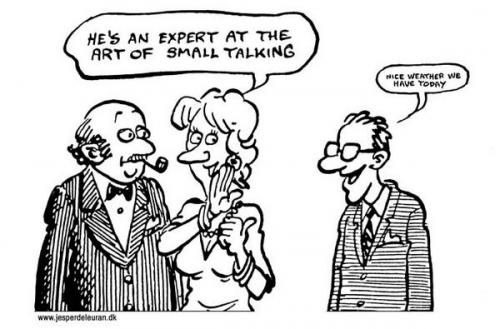Last night I was in this class, and there were eight full-time faculty members in the class to evaluate some presentations we had done, and prior to the class actually commencing there was pizza and much merriment (and some nerves related to the presentations, although I can’t say I get nervous before presentations because I’m a straight G) and as I walked around the room, contemplating writing this over-long sentence the next morning, one thing that struck me is that every single conversation I passed — whether it was about the fundamentals of a presentation about to be given, that day’s work, the pizza, business travel, sports, weather, whatever — they were all fully transactional, bordering on small talk. None was substantive in the least. Now maybe they’re not supposed to be — this is a bunch of grad students and some university coordinators sitting around eating pizza. Are we really going to be solving the world’s problems through our dialogue? And of course, it’s a small sample size. But more and more I have seen transactional dialogue replacing actual dialogue, from business to personal. So I wonder — what percentage of daily talking is that? And what does it mean?
There aren’t great stats on this because obviously every individual is different, and societies are vastly different as well — Eastern societies don’t even really know how to small talk, which can make it challenging when they get recruited by Americans, who love the walk-and-talk about the weather and “that local sports team” coming out of an interview room. There’s been research done showing that well-being can be related to less small talk and more substantive conversation, which seems logical on surface. Here’s more, from The New York Times:
But, he proposed, substantive conversation seemed to hold the key to happiness for two main reasons: both because human beings are driven to find and create meaning in their lives, and because we are social animals who want and need to connect with other people.
“By engaging in meaningful conversations, we manage to impose meaning on an otherwise pretty chaotic world,” Dr. Mehl said. “And interpersonally, as you find this meaning, you bond with your interactive partner, and we know that interpersonal connection and integration is a core fundamental foundation of happiness.”
And now here’s the ultimate rub/takeaway/application:
“It’s not that easy, like taking a pill once a day,” Dr. Mehl said. “But this has always intrigued me. Can we make people happier by asking them, for the next five days, to have one extra substantive conversation every day?”
So then, could we make our population happier — and remember, depression is a very real thing and also a massive aspect of health care costs — just by figuring out how to teach them to improve the depth of conversation they have?
Obviously a lot of this is based off a small sample size and potentially impossible within the context of your own life, but … it’s interesting to consider. In that same class last night, I saw a study that said the No. 1 activity during “on-boarding” (your first day/week as an employee somewhere) is “filling out forms/paperwork.” Not surprising, but also completely transactional. If that’s what you spend your first day doing — not necessarily meeting your manager/team, or understanding the floor plan and context of the work — how connected are you in 3 months? 6 months? Are you happy? Maybe not. So therein is another example: start shifting transactional to transformative on that element and maybe we’re creating happier, more connected people (you can fill out forms at home via a link someone sends you, you know that?). Maybe we all just need to be a little deeper.
FYI: I have no idea what these button-looking things are; they seem to have pasted over from NY Times or something.

One Comment
Comments are closed.